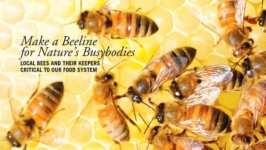How Much Water Do You Eat?
A colleague of mine in England eats no more than 2000 liters (520 gallons) of water a day. Yes, I said eats. This virtual water – the water required to produce the food we eat – can easily match or eclipse the 80–100 gallons the average American uses to bathe, wash clothes and dishes, and use the toilet.
Virtual water accounts for irrigation to grow crops, water for livestock, and energy for harvesting, packaging, and transport. For example, to produce one pound of wheat requires about 120 gallons of water. A pound of beef requires about 430 gallons of water. And a pound of coffee? More than 520 gallons of water.
Of course, production methods, growing conditions, and other factors can influence these numbers, but the concept of virtual water emphasizes the importance of water in food production. Much as the “carbon footprint” has helped us recognize our individual contribution to carbon dioxide levels in our atmosphere, the concept of virtual water indicates our “water footprint.” As the world’s population continues to grow and shift geographically, and as climate changes continue to take hold, our global water resources are under increasing threat to quantity and quality.
The virtual water concept has improved the understanding and management strategies that can be used for food and beverage production. Advances in production and manufacturing can make a big difference. Locally, MillerCoors has reduced their water-to-beer ratio by 15% over the past few years. Through better metering, less water-dependent processes, and new technologies, they’re using less water than ever before to make one of Milwaukee’s signature products.
Here in Milwaukee, we’re blessed to sit on the shores of 20% of the world’s surface fresh water. As the rest of the world faces droughts and increasing water scarcity, our supply would seem relatively secure. But we have a responsibility to steward this vital resource. Are we in Milwaukee providing examples of efficient water use for growing and processing food? Will our future water security lead to a new concentration of food growing and processing industries in this area and how will we treat them as water users?
The School of Freshwater Sciences at the University of Wisconsin-Milwaukee is committed to stewarding our freshwater future and creating the technologies to advance water-efficient food production. Our research advances in freshwater ecology, technology, and economics provide the tools and resources to propel Wisconsin’s food production industry into the future.
The School is working to develop a nascent food industry from our technology and research. Intensive Urban Aquaculture is an innovative process by which large quantities of freshwater fish are grown in repurposed urban buildings, complementing urban agriculture by providing clean sources of fish protein and omega-3 fatty acids, produced in the heart of populations that need it most. State-of-the-art urban aquaculture developed at UWM, and currently being piloted with Growing Power, promotes the use of integrated, organic fish and vegetable/plant food production systems that utilize green technology, water reuse, zero effluent discharge, and energy conservation.
The internationally acclaimed Organization for Economic Co-operation and Development (OECD), in a study commissioned by the City of Chicago, identified intensive aquaculture developed at UWM as an area of significant opportunity for the region that includes southeast Wisconsin, northern Illinois, and northern Indiana, with the potential for the entire supply chain of food production, hatcheries, grow out facilities, cleaning and prep, and equipment supply to grow up around it.
As these new industries and water-sustainable practices grow, it is our responsibility, as individuals, to support them with our purchasing and investment dollars. In our shopping baskets and our kitchens, we can reduce our virtual water consumption in two important ways. First, we can choose to limit the amount of high virtual-water foods we consume and substitute more water-sustainable choices. By swapping one cup of coffee (37 gallons of virtual water) for tea (9 gallons), one could save the equivalent of water used for a 5-minute shower. By skipping the beef once a week for a year, you could fill a backyard swimming pool with the amount of virtual water saved. We can also choose to purchase water-intensive foods produced in water-secure regions. Peaches (143 gallons per pound), for example, are more sustainably grown in water-rich Michigan, than in drought-stricken California.
The Milwaukee region potentially faces an unprecedented demand for access to water, probably not seen since its heyday at the turn of the century. I believe that Milwaukee can be a world leader in the water food management nexus – not only by adopting best practices but also by attracting new industry to the region.
For more information on reducing virtual water consumption, readers may wish to consult: www.virtualwater.eu or www.virtual-water.org





